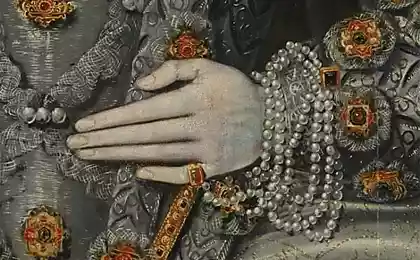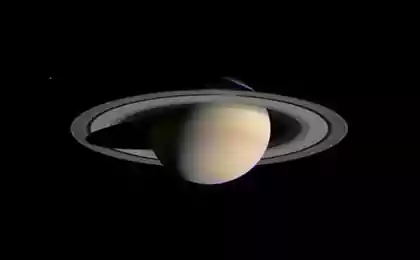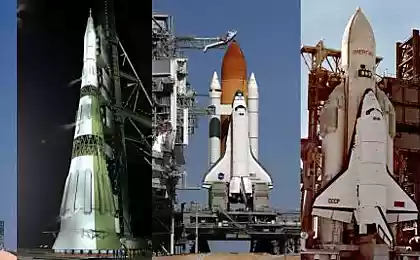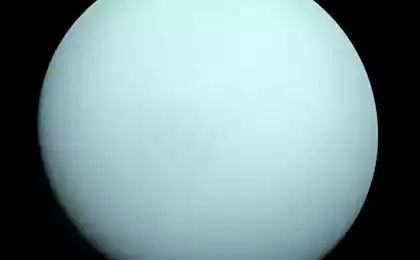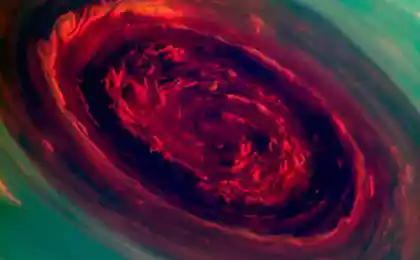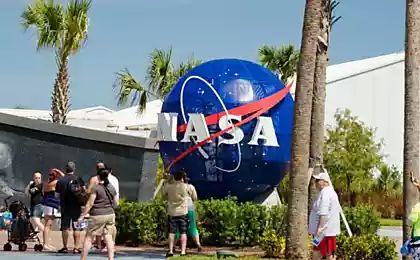1209
Saturn and its ring
In continuation of the pro Venus and Mars
forum2/st/0/topic200960.html
forum2/topic195227.html
1
One of the most amazing phenomena of the solar system, of course, should be considered as the rings of Saturn. Immediately after they were discovered, astronomers came the first question: why they are flat and thin? The answer is searched for nearly two hundred and fifty years, and finally found, but by that time accumulated dozens of new issues which only continued to multiply as the study of the planets and the solar space ... Seen through a telescope rings are dazzling. And obviously begs the question: where did these rings? And why only at Saturn?
In Roman mythology, Saturn - the god of agriculture. Associated with the Greek god Cronus (Cronus), who was the son of Uranus and Gaia and the father of Zeus (Jupiter). The root of the English word «saturday» (Saturday) is Saturn.
Saturn is the second largest planet in the Solar System after Jupiter. Like Jupiter, it refers to gas giants. The diameter of Saturn's 120 thousand kilometers, which is 10 times larger than the Earth. At this size, the density of Saturn is 8 times less than the density of the Earth. This is followed and the amazing properties of this giant, however, common to all gas giants. With a mass of 95 times the mass of the Earth, in terms of it more than 760 times! Saturn's atmosphere make cloud consisting of ammonia. On the surface of the planet (if I may say about the gas giant) raging the strongest hurricanes. The strength of the wind at the equator reaches the fantastic by our standards 1800 kilometers per hour!
Saturn has been known since prehistoric times. Galileo first observed in 1610 in his telescope; he recorded in his diary that he was very surprised by his strange appearance. Interpretation of the early observations of the planet have been hampered by the fact that the Earth every few years through the plane of Saturn's rings This type of Saturn images at low resolution has changed radically. it was not until 1659 that Christiaan Huygens (Christiaan Huygens) correctly calculated the geometry of the rings. Saturn's rings were the only ones in the solar system until 1977 when very faint rings were discovered around Uranus (and a little later around Jupiter and Neptune).

2
For the first time I discovered the rings of a planet Italian astronomer Galileo Galilei. Initially, it was suggested that the planet is surrounded by clouds of gas. After several decades of using Huygens with better tools I have determined that it was a ring. Of course, the level of development of astronomy did not allow a closer look at the structure of the ring. Indeed, while the ring appeared homogeneous. Only two centuries later turned out that the ring actually consists of millions of small particles. Later it turned out that no one around the planet, and several rings.
Finally, in the last century in the orbit of Saturn visited by space probes "Pioneer-2" (1979), "Voyager 1" (1980) and "Voyager 2" (1981), which helped to consider near the mysterious ring.
There are 3 main rings named A, B and C. They are distinguishable without any problems from the Earth. There are more faint rings - D, E, F. On closer inspection turns out to be a great variety of rings. Between the rings there are slots where no particles. The one of the slots, which can be seen in the middle telescope from Earth (between the rings A and B), called the Cassini division. On a clear night you can even see less noticeable gap. The inner parts of the outer rings rotate faster.
Saturn's rings are so wide that for him, whether it is possible, could roll Neptune or Uranus. Or both. The width of the ring is 137 000 km. At the same time, the ring has a thickness of only a few dozen meters.
All rings are composed of individual pieces of ice in size from dust to several meters in diameter. These particles move with almost identical speed (about 10 km / s, their speeds are equalized so well that adjacent particles appear stationary relative to each other), sometimes colliding with each other. Under the influence of satellite ring slightly curved, ceasing to be flat: visible shade from the sun. All the particles slowly move in opposite directions - at a speed of 1-2 mm / s.
The appearance of the rings varies from year to year. This is due to the slope of the ring plane to the plane of the orbit of the planet. The plane of the ring is inclined to the orbital plane by 26 °. Therefore, during the year we see them as large as possible, after which their visible width decreases, and after about 15 years, they become barely visible line.
3
"Voyager 1" has allowed a closer look at the structure of the rings. A plurality of slits, besides the already known for a long time the Cassini Division, prompted the scientists to hypothesize the presence of small satellites whose orbits lie within these slots, and it was believed that such satellites, however, collect all of the particles in its path. However, "Voyager 2", conducted a systematic search for such satellites, found nothing. While some astronomers still expect to find such a coexistence of satellite and crevices, numerous studies have led to the conclusion that many of the perpetrators of education gaps are indeed satellites, but only those with orbits lie outside the ring. And the mechanism of formation of cracks completely different.
And particles, and moons around Saturn, subject to the laws of Kepler, of which, in particular, is that the farther from the center of the body, around which it is drawn, the greater the period of his treatment. This means that within the period of revolution of the particles rings around Saturn depends only on the distance from the planet. For any of the satellite there is a ring for which a longer period of the satellite will be a multiple of the orbital period of particles in this ring. For example, the orbital period of the satellite will be almost exactly three times more than the period of revolution of the particles. This satellite at regular intervals alters the movement of these particles, and they leave, with time, its orbit, forming a thin slit, almost free of particles. Thus, each slot is the impact a particular satellite, "person" is easily found out. Astronomers say that this gap satellite graze. Here the word "herding" is used as a term, and satellites are eyeing for slots in the ring of Saturn, called "shepherds."

4
Already the first shots ring passed AMC "Voyager 1" showed slight color variations in the rings, the gap in the ring C, the presence of substances in the Cassini division, and changes in the distribution and brightness of the substance in the rings C and B. The most interesting details on the first shots were "spokes" - dark radial formation, crossing some bright areas of B. Sometimes the "spokes" have been observed for a few hours, although the inner edge of the ring at the base of "spokes" revolves around the planet at a faster rate than the outer edge at the top of the "spokes" and these formations would have to be destroyed.
Later images were obtained "spokes" in the dispersal of sunlight ahead. These pictures spoke light field instead of the dark, as the first images taken with the light scattering back. This suggested that the field of "spokes" contain very small fines. The area, where there are "spokes", covers the area of the rings orbiting Saturn at the same rate as its magnetic field. This, according to some scientists, may explain the stability of the spokes, in spite of the different speeds of the particles. The researchers hypothesized that the interaction between these particles and Morris particles by electrostatic forces may be concentrated in certain areas or raised above the plane of the rings.
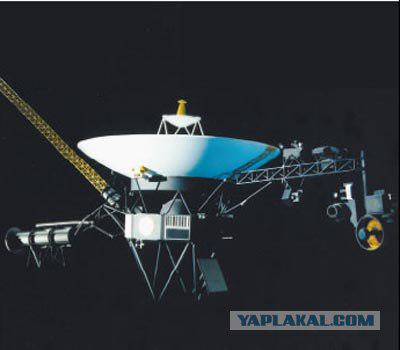
5
If the ring is loaded, the particles therein have to repel each other, but retain their gravity ring. For large particle gravity greater repulsive forces and remain in the ring, for small particle repulsion forces more, and they are raised above the plane of the ring. It has been hypothesized that the planet's magnetic field acts on the charged fine particles that are above the Ring, "building them like iron filings" or making coalesce. Another hypothesis explains the existence of the spokes around the ring wave phenomena that affect the small particles in the path of the wave. Mechanisms causing charged ring, is unclear. A hypothesis about what is happening under the influence of Saturn's atmosphere, or high-energy ultraviolet radiation from the sun.
Pictures showed that each of the six previously observed Saturn's rings (D, C, B, A, F, E - in order of increasing distance from the planet) is composed of a large number of narrow rings. It was believed that after the complete image processing can count 500 - 1000 of narrow rings. Several narrow rings was found in the Cassini division, which was previously thought space relatively free of the substance.
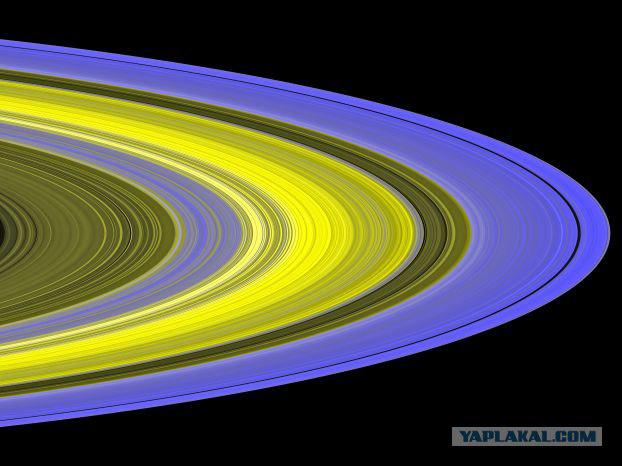
6
From time to time you can watch the spectacle of an effective - the collision of two large particles. Here are two chunks the size of a garden house soprikosatsya begin slowly with each other, moving from the surface of the whole drifts of loose snow. They were not lucky: they did not stand the pressure of the mutual impact and slowly falling apart. Typical of the Rings "catastrophe" at a speed of a millimeter per second! Two remnants of the original bodies continue to move, as they dropped from snow drifts, snow dust lumps and slowly scatter in different directions, sparkling in the rays of the distant sun. A few days later, "victims" of the particle will rise again, catching and absorbing a huge number of smaller snowballs at rings.
With ring - the least striking of the three "classic" rings (A, B and C). Apparently, there is spread more material. The most striking is the B ring, which should be the highest density of matter. The particles are arranged in a ring so thick that, having flown seridiny, we lose sight of the stars.
In addition to classic rings in the pictures transmitted AMC "Voyager 1", you can see the closest planet to the ring D. It is believed that it is formed by a substance that has penetrated through the barrier that forms the inner edge of the ring C.
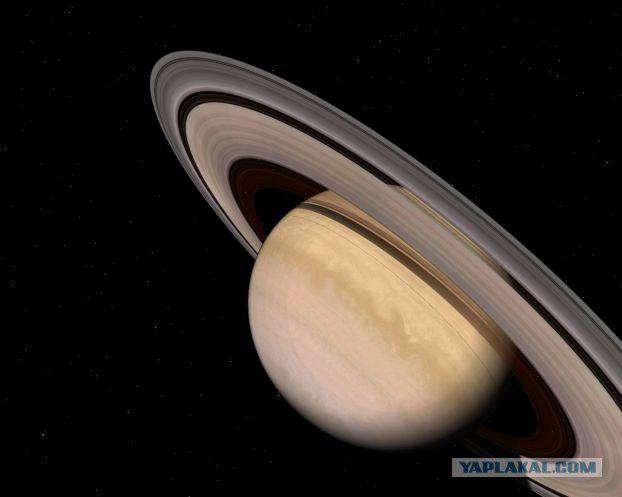
7
Ring F, judging by the pictures, it may have some elliptical, some portions of the thin rings closer to the planet than other areas. This ring is apparently formed by two, and possibly three loosely interwoven "strands". Scientists are at a loss to explain this phenomenon. According to one hypothesis, since the ring F is composed of dust particles, they can acquire an electrical charge from sunlight or from particles of solar origin and get properties miniature electromagnet. In this case, their interaction with Saturn's magnetic field could lead to interlocking rings. Around the F ring found clumps of matter. One of them was so dense that it initially took over the satellite. Subsequent analysis showed that it is - an area concentration of the substance having a characteristic size of 100 - 200 km.
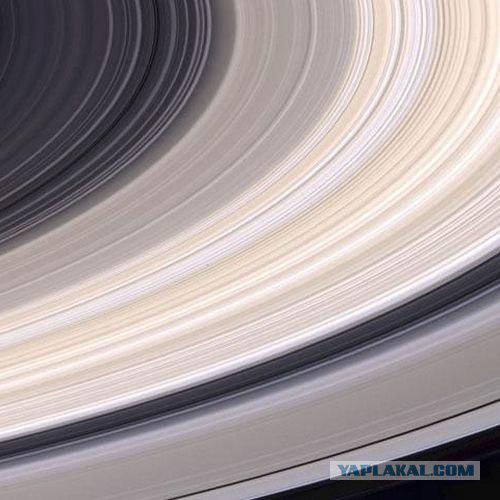
8
The origin of the rings
For a long time it was thought that Saturn approached a satellite careless and it was torn by tidal forces "in pieces." But these "Voyager" disproved this widespread opinion. Now it found that the rings of Saturn (and the other planets, too) are the remains of a huge cloud stretching circumplanetary many millions of kilometers.
From the outer regions of the clouds formed satellites and satellites in the internal education was "finished." Since the speed of mutual collisions are growing at the approach to the planet, near every planet there is a region where particles reached opredelennyz sizes begin to crumble from mutual collisions. Billions of years of collisions - and 10-meter particles have reached such a loose state that crumble at the slightest push to speed mm / s. Any large particles for a few days or weeks of a complete cycle from destruction to recovery.
This mutual competition, not giving form large satellites, weakens with distance from the planet, and at a certain distance of the substance is transformed into satellites, and part is still in a fragmented state - in the form of rings. By the way, the ring during its existence has made revolutions trillion - more than the moons or planets in their orbits. The total mass of Saturn's icy rings comparable to the mass of its satellite Mimas, whose radius of 200 km.
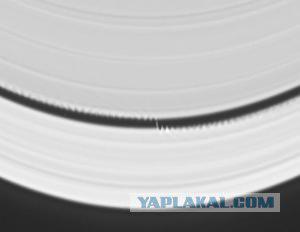
Source:
forum2/st/0/topic200960.html
forum2/topic195227.html
1
One of the most amazing phenomena of the solar system, of course, should be considered as the rings of Saturn. Immediately after they were discovered, astronomers came the first question: why they are flat and thin? The answer is searched for nearly two hundred and fifty years, and finally found, but by that time accumulated dozens of new issues which only continued to multiply as the study of the planets and the solar space ... Seen through a telescope rings are dazzling. And obviously begs the question: where did these rings? And why only at Saturn?
In Roman mythology, Saturn - the god of agriculture. Associated with the Greek god Cronus (Cronus), who was the son of Uranus and Gaia and the father of Zeus (Jupiter). The root of the English word «saturday» (Saturday) is Saturn.
Saturn is the second largest planet in the Solar System after Jupiter. Like Jupiter, it refers to gas giants. The diameter of Saturn's 120 thousand kilometers, which is 10 times larger than the Earth. At this size, the density of Saturn is 8 times less than the density of the Earth. This is followed and the amazing properties of this giant, however, common to all gas giants. With a mass of 95 times the mass of the Earth, in terms of it more than 760 times! Saturn's atmosphere make cloud consisting of ammonia. On the surface of the planet (if I may say about the gas giant) raging the strongest hurricanes. The strength of the wind at the equator reaches the fantastic by our standards 1800 kilometers per hour!
Saturn has been known since prehistoric times. Galileo first observed in 1610 in his telescope; he recorded in his diary that he was very surprised by his strange appearance. Interpretation of the early observations of the planet have been hampered by the fact that the Earth every few years through the plane of Saturn's rings This type of Saturn images at low resolution has changed radically. it was not until 1659 that Christiaan Huygens (Christiaan Huygens) correctly calculated the geometry of the rings. Saturn's rings were the only ones in the solar system until 1977 when very faint rings were discovered around Uranus (and a little later around Jupiter and Neptune).

2
For the first time I discovered the rings of a planet Italian astronomer Galileo Galilei. Initially, it was suggested that the planet is surrounded by clouds of gas. After several decades of using Huygens with better tools I have determined that it was a ring. Of course, the level of development of astronomy did not allow a closer look at the structure of the ring. Indeed, while the ring appeared homogeneous. Only two centuries later turned out that the ring actually consists of millions of small particles. Later it turned out that no one around the planet, and several rings.
Finally, in the last century in the orbit of Saturn visited by space probes "Pioneer-2" (1979), "Voyager 1" (1980) and "Voyager 2" (1981), which helped to consider near the mysterious ring.
There are 3 main rings named A, B and C. They are distinguishable without any problems from the Earth. There are more faint rings - D, E, F. On closer inspection turns out to be a great variety of rings. Between the rings there are slots where no particles. The one of the slots, which can be seen in the middle telescope from Earth (between the rings A and B), called the Cassini division. On a clear night you can even see less noticeable gap. The inner parts of the outer rings rotate faster.
Saturn's rings are so wide that for him, whether it is possible, could roll Neptune or Uranus. Or both. The width of the ring is 137 000 km. At the same time, the ring has a thickness of only a few dozen meters.
All rings are composed of individual pieces of ice in size from dust to several meters in diameter. These particles move with almost identical speed (about 10 km / s, their speeds are equalized so well that adjacent particles appear stationary relative to each other), sometimes colliding with each other. Under the influence of satellite ring slightly curved, ceasing to be flat: visible shade from the sun. All the particles slowly move in opposite directions - at a speed of 1-2 mm / s.
The appearance of the rings varies from year to year. This is due to the slope of the ring plane to the plane of the orbit of the planet. The plane of the ring is inclined to the orbital plane by 26 °. Therefore, during the year we see them as large as possible, after which their visible width decreases, and after about 15 years, they become barely visible line.
3
"Voyager 1" has allowed a closer look at the structure of the rings. A plurality of slits, besides the already known for a long time the Cassini Division, prompted the scientists to hypothesize the presence of small satellites whose orbits lie within these slots, and it was believed that such satellites, however, collect all of the particles in its path. However, "Voyager 2", conducted a systematic search for such satellites, found nothing. While some astronomers still expect to find such a coexistence of satellite and crevices, numerous studies have led to the conclusion that many of the perpetrators of education gaps are indeed satellites, but only those with orbits lie outside the ring. And the mechanism of formation of cracks completely different.
And particles, and moons around Saturn, subject to the laws of Kepler, of which, in particular, is that the farther from the center of the body, around which it is drawn, the greater the period of his treatment. This means that within the period of revolution of the particles rings around Saturn depends only on the distance from the planet. For any of the satellite there is a ring for which a longer period of the satellite will be a multiple of the orbital period of particles in this ring. For example, the orbital period of the satellite will be almost exactly three times more than the period of revolution of the particles. This satellite at regular intervals alters the movement of these particles, and they leave, with time, its orbit, forming a thin slit, almost free of particles. Thus, each slot is the impact a particular satellite, "person" is easily found out. Astronomers say that this gap satellite graze. Here the word "herding" is used as a term, and satellites are eyeing for slots in the ring of Saturn, called "shepherds."

4
Already the first shots ring passed AMC "Voyager 1" showed slight color variations in the rings, the gap in the ring C, the presence of substances in the Cassini division, and changes in the distribution and brightness of the substance in the rings C and B. The most interesting details on the first shots were "spokes" - dark radial formation, crossing some bright areas of B. Sometimes the "spokes" have been observed for a few hours, although the inner edge of the ring at the base of "spokes" revolves around the planet at a faster rate than the outer edge at the top of the "spokes" and these formations would have to be destroyed.
Later images were obtained "spokes" in the dispersal of sunlight ahead. These pictures spoke light field instead of the dark, as the first images taken with the light scattering back. This suggested that the field of "spokes" contain very small fines. The area, where there are "spokes", covers the area of the rings orbiting Saturn at the same rate as its magnetic field. This, according to some scientists, may explain the stability of the spokes, in spite of the different speeds of the particles. The researchers hypothesized that the interaction between these particles and Morris particles by electrostatic forces may be concentrated in certain areas or raised above the plane of the rings.

5
If the ring is loaded, the particles therein have to repel each other, but retain their gravity ring. For large particle gravity greater repulsive forces and remain in the ring, for small particle repulsion forces more, and they are raised above the plane of the ring. It has been hypothesized that the planet's magnetic field acts on the charged fine particles that are above the Ring, "building them like iron filings" or making coalesce. Another hypothesis explains the existence of the spokes around the ring wave phenomena that affect the small particles in the path of the wave. Mechanisms causing charged ring, is unclear. A hypothesis about what is happening under the influence of Saturn's atmosphere, or high-energy ultraviolet radiation from the sun.
Pictures showed that each of the six previously observed Saturn's rings (D, C, B, A, F, E - in order of increasing distance from the planet) is composed of a large number of narrow rings. It was believed that after the complete image processing can count 500 - 1000 of narrow rings. Several narrow rings was found in the Cassini division, which was previously thought space relatively free of the substance.

6
From time to time you can watch the spectacle of an effective - the collision of two large particles. Here are two chunks the size of a garden house soprikosatsya begin slowly with each other, moving from the surface of the whole drifts of loose snow. They were not lucky: they did not stand the pressure of the mutual impact and slowly falling apart. Typical of the Rings "catastrophe" at a speed of a millimeter per second! Two remnants of the original bodies continue to move, as they dropped from snow drifts, snow dust lumps and slowly scatter in different directions, sparkling in the rays of the distant sun. A few days later, "victims" of the particle will rise again, catching and absorbing a huge number of smaller snowballs at rings.
With ring - the least striking of the three "classic" rings (A, B and C). Apparently, there is spread more material. The most striking is the B ring, which should be the highest density of matter. The particles are arranged in a ring so thick that, having flown seridiny, we lose sight of the stars.
In addition to classic rings in the pictures transmitted AMC "Voyager 1", you can see the closest planet to the ring D. It is believed that it is formed by a substance that has penetrated through the barrier that forms the inner edge of the ring C.

7
Ring F, judging by the pictures, it may have some elliptical, some portions of the thin rings closer to the planet than other areas. This ring is apparently formed by two, and possibly three loosely interwoven "strands". Scientists are at a loss to explain this phenomenon. According to one hypothesis, since the ring F is composed of dust particles, they can acquire an electrical charge from sunlight or from particles of solar origin and get properties miniature electromagnet. In this case, their interaction with Saturn's magnetic field could lead to interlocking rings. Around the F ring found clumps of matter. One of them was so dense that it initially took over the satellite. Subsequent analysis showed that it is - an area concentration of the substance having a characteristic size of 100 - 200 km.

8
The origin of the rings
For a long time it was thought that Saturn approached a satellite careless and it was torn by tidal forces "in pieces." But these "Voyager" disproved this widespread opinion. Now it found that the rings of Saturn (and the other planets, too) are the remains of a huge cloud stretching circumplanetary many millions of kilometers.
From the outer regions of the clouds formed satellites and satellites in the internal education was "finished." Since the speed of mutual collisions are growing at the approach to the planet, near every planet there is a region where particles reached opredelennyz sizes begin to crumble from mutual collisions. Billions of years of collisions - and 10-meter particles have reached such a loose state that crumble at the slightest push to speed mm / s. Any large particles for a few days or weeks of a complete cycle from destruction to recovery.
This mutual competition, not giving form large satellites, weakens with distance from the planet, and at a certain distance of the substance is transformed into satellites, and part is still in a fragmented state - in the form of rings. By the way, the ring during its existence has made revolutions trillion - more than the moons or planets in their orbits. The total mass of Saturn's icy rings comparable to the mass of its satellite Mimas, whose radius of 200 km.

Source:
